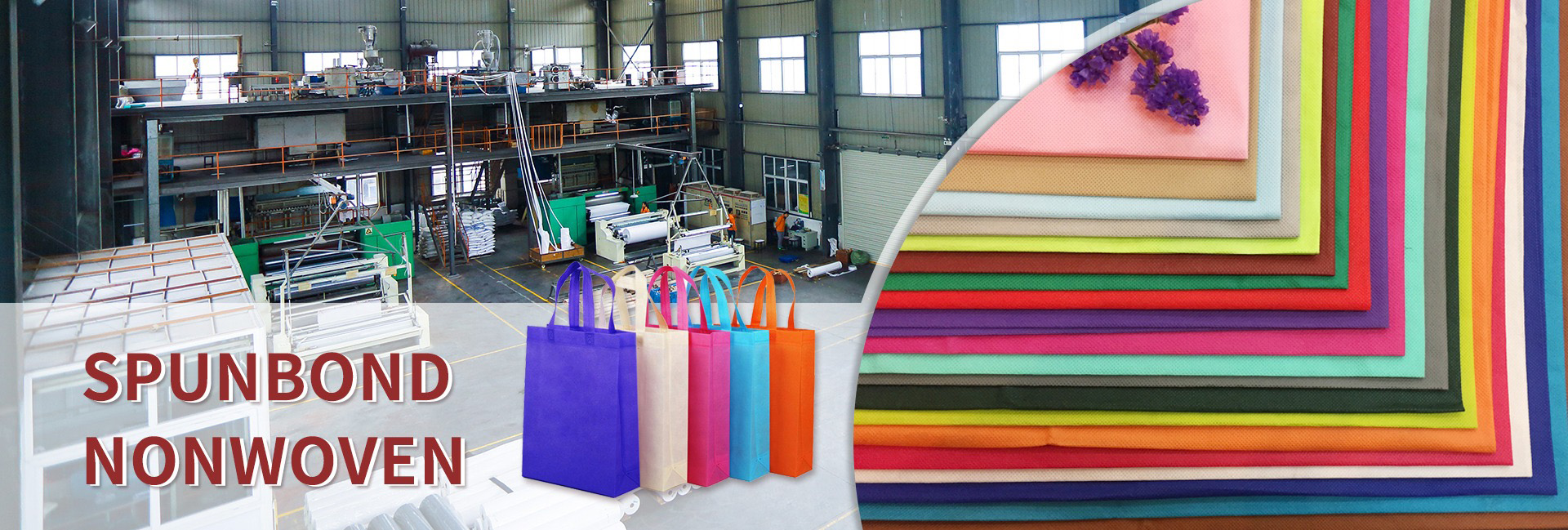Non-woven spunbond fabric is a type of non-woven material made through the spunbond process, where continuous filaments of synthetic polymers (like polypropylene, polyester, or nylon) are extruded, stretched, and laid onto a conveyor belt. These filaments are then bonded together using heat, chemicals, or mechanical methods to form a strong, uniform fabric. Unlike woven fabrics, it does not require weaving or knitting, making it cost-effective and efficient to produce.
How It’s Made
- Polymer Extrusion: Synthetic polymers are melted and extruded through spinnerets to form continuous filaments.
- Filament Stretching: The filaments are stretched to align the molecules and increase strength.
- Web Formation: The filaments are laid randomly onto a conveyor belt to form a web.
- Bonding: The web is bonded using heat, chemicals, or mechanical methods to create a cohesive fabric.
- Finishing: The fabric may be treated for additional properties like water resistance or UV protection.
Non-woven spunbond fabric is a highly functional material that combines strength, durability, and versatility, making it a popular choice for a wide range of applications.
Differentiation between woven and nonwoven fabrics?
Woven and nonwoven fabrics are two distinct types of textiles, each with unique characteristics, manufacturing processes, and applications. Here’s a detailed comparison:
Manufacturing Process
Woven Fabrics:
- Made by interlacing two sets of yarns (warp and weft) at right angles on a loom.
- The process involves weaving, which can be done manually or by machines.
- Examples: Denim, cotton shirts, silk sarees, and linen.
Nonwoven Fabrics:
- Made by bonding or interlocking fibers together using mechanical, chemical, or thermal processes.
- No weaving or knitting is involved; fibers are directly formed into a fabric web.
- Examples: Spunbond fabric, meltblown fabric, and wet wipes.
Summary Table
| Aspect | Woven Fabrics | Nonwoven Fabrics |
|---|---|---|
| Manufacturing | Interlacing warp and weft yarns on a loom. | Bonding fibers mechanically/chemically. |
| Structure | Grid-like, visible yarns. | Random fiber arrangement, no visible yarns. |
| Durability | Strong and durable. | Less durable, often disposable. |
| Breathability | Depends on weave and fiber. | Generally more porous and breathable. |
| Cost | More expensive. | Cheaper and faster to produce. |
| Applications | Apparel, home textiles, industrial uses. | Medical, hygiene, agriculture, filtration. |
| **Environmental Impact | Reusable, biodegradable options. | Often disposable, some recyclable options. |
| Flexibility | Less flexible, can be stiff. | Soft and flexible. |
Key Takeaway
Woven fabrics are ideal for durable, long-lasting products like clothing and home textiles, while nonwoven fabrics are better suited for disposable or single-use applications like medical products, filtration, and packaging. The choice between the two depends on the specific requirements of the application.
Importance of Spunbond Nonwoven Fabrics
- Spunbond nonwoven fabrics are used in a wide range of applications across multiple industries, including medical, agriculture, packaging, automotive, and more. Their adaptability makes them indispensable in many sectors.
- The production process of spunbond nonwoven fabrics is relatively simple and fast, making them more economical compared to traditional woven fabrics. This cost efficiency is particularly beneficial for large-scale applications.
- Despite being lightweight, spunbond nonwoven fabrics are strong and durable. They offer excellent resistance to tearing and punctures, making them suitable for demanding applications.
- Spunbond nonwoven fabrics are highly breathable, allowing air and moisture to pass through. This property is crucial for applications like medical gowns, masks, and agricultural covers.
- Their lightweight nature makes them easy to handle, transport, and apply in various uses, from disposable medical products to geotextiles.
- Many spunbond nonwoven fabrics are recyclable or made from biodegradable materials, contributing to environmental sustainability. This is increasingly important as industries seek greener alternatives.
- Spunbond nonwoven fabrics can be engineered to provide excellent barrier properties against liquids, bacteria, and particles. This makes them ideal for medical and hygiene products like surgical masks, gowns, and diapers.
- The properties of spunbond nonwoven fabrics can be tailored to meet specific requirements, such as varying levels of strength, porosity, and water resistance. This customization enhances their applicability in diverse fields.
- In the medical and hygiene sectors, spunbond nonwoven fabrics are essential for maintaining sterility and preventing contamination. They are used in products like surgical drapes, wound dressings, and sanitary napkins.
- In agriculture, spunbond nonwoven fabrics protect crops from pests, UV rays, and extreme weather conditions. They also help in weed control and soil stabilization, promoting healthier crop growth.
- Spunbond nonwoven fabrics are widely used in geotextiles for erosion control, soil stabilization, and drainage systems. Their durability and permeability make them ideal for civil engineering projects.
- They are used in packaging for their strength and protective qualities. Spunbond nonwoven fabrics are employed in shopping bags, protective wraps, and gift packaging.
- In the automotive sector, spunbond nonwoven fabrics are used for interior linings, insulation, and filtration. Their lightweight nature contributes to fuel efficiency and overall vehicle performance.They are used in various industrial applications, including protective covers for machinery, reinforcement materials, and insulation. Their durability and resistance to harsh conditions make them suitable for industrial environments.Spunbond nonwoven fabrics are effective in filtration applications, such as air and liquid filters. Their porous structure allows for efficient filtration while maintaining airflow or liquid flow.
Spunbond nonwoven fabrics are crucial due to their versatility, cost-effectiveness, durability, and adaptability. They play a vital role in numerous industries, from healthcare and agriculture to automotive and packaging, offering solutions that are both functional and sustainable. Their importance is likely to grow as technology advances and new applications are discovered.
Dongguan Liansheng Non woven Technology Co., Ltd. was established in May 2020. It is a large-scale non-woven fabric production enterprise integrating research and development, production, and sales. It can produce various colors of PP spunbond non-woven fabrics with a width of less than 3.2 meters from 9 grams to 300 grams.
Post time: Feb-17-2025

